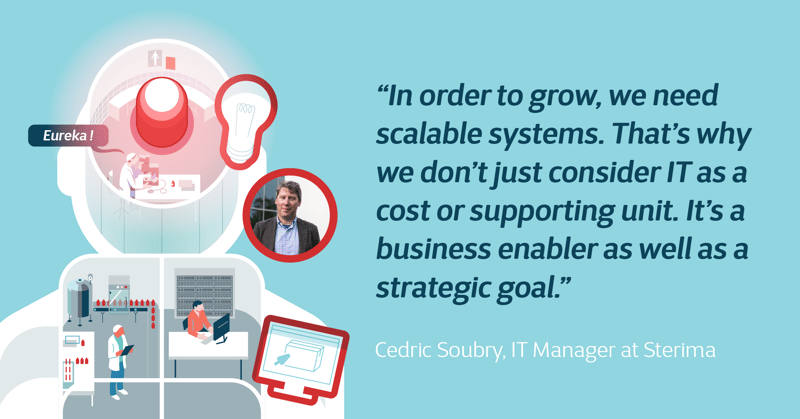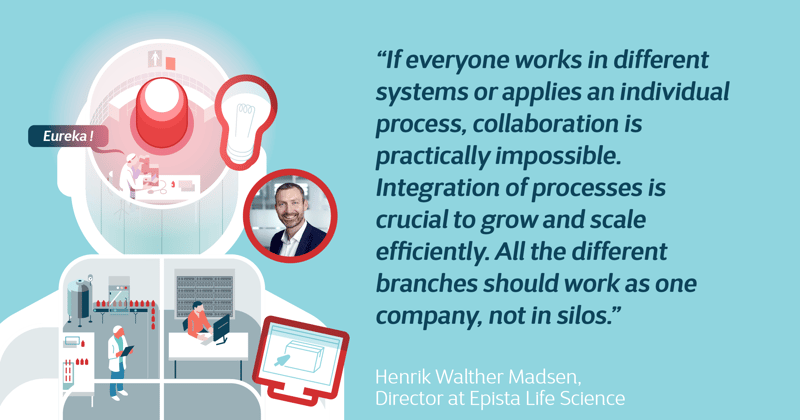Part 2: Growth and Scalability
The exponential growth of life sciences companies
Imagine a pharmaceutical startup that is researching a new drug. During the R&D stages, operations are quite limited and the company will not grow immensely. If all goes well, the drug will prove efficient and pass through the different phases of approval. At this point, it’s likely the company will see its stock skyrocketing.
Once the drug hits the market, it’s time for the early investments to translate into big profits. With that come new challenges like drug manufacturing, distribution and hiring new employees to manage all this.
Broadly speaking, these kinds of exponential growth are quite rare, but not in the life sciences industry. More than in any other industry perhaps, challenges that come with growth and scalability are very real and imminent. So how to prepare for this sudden and exponential growth?
Onboarding employees and transferring knowledge
One of the key measures of growth is your workforce. Hiring new employees, broadening your knowledge and skills and transferring this knowledge are crucial to support and enable growth within the company. Moreover, when companies expand internationally, they should strive for a coherent approach and holistic overview of these HR practices throughout the different branches of the company.
Flanders-based Inovet currently employs 190 people. About 60 of them work in the Belgian HQ, while the manufacturing site in France employs 130 people. Additionally, Inovet has sales hubs in countries like Vietnam and Hungary.
Lara Moons: “International expansion requires technology that enables collaboration and unified processes in each country. On top of that, we wanted a steady platform to easily set up sales hubs in new countries. Ideally, the system lets you copy-paste the same approach without having to do any custom development. The goal, eventually, is to have a system that supports your business processes, instead of relying on people. As long as the expertise and procedures are strictly in people’s heads, your growth will be stunted. So expanding your workforce is only possible once you have centralized data and unified processes in place.”
The importance of scalability
Scalability is the foundation of national and international growth. Companies working with outdated or hardly scalable systems, may run smoothly in steady times. But in times of growth – for instance by acquiring another company or expanding internationally – , these systems will prove to be a liability and even an obstacle.
At Belgian-based company Sterima, IT is regarded as an enabler for growth.

Cedric Soubry: “Our growth ambition is twofold: we want to expand our current business and introduce new lines of business through innovation. We wanted an application landscape that quickly and efficiently onboards new clients, processes new products and services and expands the operational scope.”
In its simplest definition, scalability is the property of a process, computer system or company to scale up or down efficiently. Scalability can be necessary in different situations:
- expanding workload (e.g. increasing manufacturing volumes)
- expanding scope (e.g. expanding products and services portfolio)
- acquisitions
- geographic expansion
- new operational demands (e.g. digitalization of manual processes like inventory management)
A scalable solution is one that is able to keep the level of performance and efficiency while expanding the scope or volume of the operations. Without it, quick growth is virtually impossible.
Klavs Esbjerg, CEO of Epista: “For biotech companies, there is an extra complexity to scalability. The number of markets or variations of a product may increase quickly, so flexibility is absolutely crucial. Ideally, your company can grow within an existing, scalable system. Of course, the way to do that is to go back to standard. It is often preferable to opt for less functionalities within the system, and to focus on your core activities as the standard. Keep it simple: go for a scalable, global and harmonized platform that stays close to the standard.”
Intercompany collaboration
When expanding internationally, intercompany collaboration becomes more important. One of the key challenges in the collaborative model, is implementing the right tools and platforms to safely and efficiently cooperate. A central aspect of this collaboration, is to integrate the processes in such a way that each branch and unit of the company works in the same way.
Henrik Walther Madsen, Director at Epista Life Science. “The companies we work with usually have a huge scale, with multiple offices and cooperation around the globe. Each of them has the same challenge on top of their agenda: coherence between different lines of business.

A concrete example of how to integrate business processes comes from Inovet. Lara Moons: “Although our HQ in Belgium purchases the raw materials, they are processed in our manufacturing plant in France. In our old way of working, the financial processing of these transfers was a huge manual burden. The plant operated as a third party logistics partner, they were in effect two separate companies. After unifying our processes, our finance unit is constantly selling the materials between companies. This way of working is much more accurate and efficient. Yet, this wouldn’t be possible without an integrated system that fully automates this back-and-forth purchasing of materials between the companies.”
Supply chain collaboration
Not only within the company, the need for collaboration with the entire business relations network increases with growth. Throughout the entire supply chain, companies are also sharing data. Every link in the supply chain processes data that is useful to all shareholders. Unifying these data streams enables complete supply chain visibility.
Henrik Walther Madsen: “Today, this intense collaboration and data sharing is quite expensive, but it is definitely an upcoming trend. In this vision, every party in the supply chain could fully trace any delays and deliver all information in one centralized platform anonymously. Some clients are even performing a track and trace on pharmaceutical products, which means they can also block vendors that are not compliant. We expect this ecosystem to break through in the near future. Again, having the right application landscape that is scalable both horizontally and vertically will be crucial to keep up with these demands.”
It's clear that the pharma and life sciences industry offers companies many challenges. Both the rapidly evolving industry and the quick growth within a company require flexible solutions. So how to tackle all these challenges, and even turn them into opportunities? Find out in part 3 of this series: Digitalization and innovation.
In the Pharma & Life Sciences industry, regulatory compliance has become a prerequisite for doing business. If you're wondering how to keep the pressure on compliancy and validation, make sure to read the first part of our series: Managing regulatory compliance!
Curious to find out more about our validated Microsoft Dynamics 365 for Pharma solution?
Get in touch and let’s talk!
.jpg?width=56&height=56&name=download%20(2).jpg)




